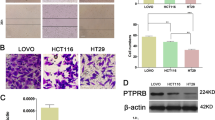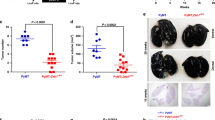Abstract
Development of human tumors is driven by accumulation of alterations in tumor suppressor genes and oncogenes in cells. The POU1F1 transcription factor (also known Pit-1) is expressed in the mammary gland and its overexpression induces profound phenotypic changes in proteins involved in breast cancer progression. Patients with breast cancer and elevated expression of Pit-1 show a positive correlation with the occurrence of distant metastasis and poor overall survival. However, some mediators of Pit-1 actions are still unknown. Here, we show that CXCR4 chemokine receptor and its ligand CXCL12 play a critical role in the pro-tumoral process induced by Pit-1. We found that Pit-1 increases mRNA and protein in both CXCR4 and CXCL12. Knock-down of CXCR4 reduces tumor growth and spread of Pit-1 overexpressing cells in a zebrafish xenograft model. Furthermore, we described for the first time pro-angiogenic effects of Pit-1 through the CXCL12-CXCR4 axis, and that extravasation of Pit-1 overexpressing breast cancer cells is strongly reduced in CXCL12-deprived target tissues. Finally, in breast cancer patients, expression of Pit-1 in primary tumors was found to be positively correlated with CXCR4 and CXCL12, with specific metastasis in liver and lung, and with clinical outcome. Our results suggest that Pit-1-CXCL12-CXCR4 axis could be involved in chemotaxis guidance during the metastatic process, and may represent prognostic and/or therapeutic targets in breast tumors.
This is a preview of subscription content, access via your institution
Access options
Subscribe to this journal
Receive 50 print issues and online access
$259.00 per year
only $5.18 per issue
Buy this article
- Purchase on Springer Link
- Instant access to full article PDF
Prices may be subject to local taxes which are calculated during checkout






Similar content being viewed by others
References
Lambert AW, Pattabiraman DR, Weinberg RA, Emerging biological principles of metastasis. Cell. 2017;68:670–91.
Valastyan S, Weinberg RA, Tumor metastasis: molecular insights and evolving paradigms. Cell. 2011;147:275–92.
Nguyen DXl, Bos PD, Massagué J, Metastasis: from dissemination to organ-specific colonization. Nat Rev Cancer. 2009;9:274–84.
Müller A, Homey B, Soto H, Ge N, Catron D, Buchanan ME, et al. Involvement of chemokine receptors in breast cancer metastasis. Nature. 2001;410:50–6.
Zlotnik A, Burkhardt AM, Homey B, Homeostatic chemokine receptors and organ-specific metastasis. Nat Rev Immunol. 2011;11:597–606.
Lazennec G, Richmond A, Chemokines and chemokine receptors: new insights into cancer-related inflammation. Trends Mol Med. 2010;16:133–44.
Burger JA, Kipps TJ, CXCR4: a key receptor in the crosstalk between tumor cells and their microenvironment. Blood. 2006;107:1761–7.
Smith MC, Luker KE, Garbow JR, Prior JL, Jackson E, Piwnica-Worms D, et al. CXCR4 regulates growth of both primary and metastatic breast cancer. Cancer Res. 2004;64:8604–12.
Bachelder RE, Wendt MA, Mercurio AM, Vascular endothelial growth factor promotes breast carcinoma invasion in an autocrine manner by regulating the chemokine receptor CXCR4. Cancer Res. 2002;62:7203–06.
Guo F, Wang Y, Liu J, Mok SC, Xue F, Zhang W, CXCL12/CXCR4: a symbiotic bridge linking cancer cells and their stromal neighbors in oncogenic communication networks. Oncogene. 2016;35:816–26.
Lefevre C, Imagawa M, Dana S, Grindlay J, Bodner M, Karin M, Tissue specific expression of the human growth hormone gene is conferred in part by the binding of a specific trans-acting factor. EMBO J. 1987;6:971–81.
Nelson C, Albert VR, Elsholtz HP, Lu LI-W, Rosenfeld MG, Activation of cell specific expression of rat growth hormone and prolactin genes by a common transcription factor. Science. 1988;239:1400–05.
Gil-Puig C, Blanco M, Garcia-Caballero T, Segura C, Perez-Fernandez R, Pit-1/GHF-1 and GH expression in MCF-7 human breast adenocarcinoma cell line. J Endocrinol. 2002;173:161–7.
Gil-Puig C, Seoane S, Blanco M, Macia M, Garcia-Caballero T, Segura C, et al. Pit-1 is expressed in normal and tumoral human breast and regulates growth hormone secretion and cell proliferation. Eur J Endocrinol. 2005;153:335–44.
Sendon-Lago J, Seoane S, Eiro N, Bermudez MA, Macia M, Garcia-Caballero T, et al. Cancer progression by breast tumors with Pit-1-overexpression is blocked by inhibition of metalloproteinase (MMP)-13. Breast Cancer Res. 2014;16:505.
Ben-Batalla I, Seoane S, Garcia-Caballero T, Gallego R, Macia M, Gonzalez LO, et al. Deregulation of the Pit-1 transcription factor in human breast cancer cells promotes tumor growth and metastasis. J Clin Invest. 2010;120:4289–302.
Gao Z, Xue K, Zhang L, Wei M, Over-expression of POU class 1 homeobox 1 transcription factor (Pit-1) predicts poor prognosis for breast cancer patients. Med Sci Monit. 2016;22:4121–25.
Gyorffy B, Lanczky A, Eklund AC, Denkert C, Budczies J, Li Q, et al. An online survival analysis tool to rapidly assess the effect of 22,277 genes on breast cancer prognosis using microarray data of 1,809 patients. Breast Cancer Res Treat. 2010;123:725–31.
Lefort S, Thuleau A, Kieffer Y, Sirven P, Bieche I, Marangoni E, et al. CXCR4 inhibitors could benefit to HER2 but not to triple-negative breast cancer patients. Oncogene. 2017;36:1211–22.
Chen HW, Du CW, Wei XL, Khoo US, Zhang GJ, Cytoplasmic CXCR4 high-expression exhibits distinct poor clinicopathological characteristics and predicts poor prognosis in triple-negative breast cancer. Curr Mol Med. 2013;13:410–16.
DeVries ME, Kelvin AA, Xu L, Ran L, Robinson J, Kelvin DJ, Defining the origins and evolution of the chemokine/chemokine receptor system. J Immunol. 2006;176:401–15.
Doitsidou M, Reichman-Fried M, Stebler J, Koprunner M, Dorries J, Meyer D, et al. Guidance of primordial germ cell migration by the chemokine SDF-1. Cell. 2002;111:647–59.
Tiveron M-C, Cremer H, CXCL12/CXCR4 signaling in neuronal cell migration. Curr Opin Neurobiol. 2008;18:237–44.
Palevitch O, Abraham E, Borodovsky N, Levkowitz G, Zohar Y, Gothilf Y, Cxcl12a-Cxcr4b signaling is important for proper development of the forebrain GnRH system in zebrafish. Gen Comp Endocrinol. 2010;165:262–68.
Nica G, Herzog W, Sonntag C, Hammerschmidt M. Zebrafish pit1 mutants lack three pituitary cell types and develop severe dwarfism. Mol Endocrinol. 2004;18:1196–209.
Tulotta C, Stefanescu C, Beletkaia E, Bussmann J, Tarbashevich K, Schmidt T, et al. Inhibition of signaling between human CXCR4 and zebrafish ligands by the small molecule IT1t impairs the formation of triple-negative breast cancer early metastases in a zebrafish xenograft model. Dis Model Mech. 2016;9:141–53.
Huang EH, Singh B, Cristofanilli M, Gelovani J, Wei C, Vincent L, et al. A CXCR4 antagonist CTCE-9908 inhibits primary tumor growth and metastasis of breast cancer. J Surg Res. 2009;155:231–6.
Hassan S, Buchanan M, Jahan K, Aguilar-Mahecha A, Gaboury L, Muller WJ, et al. CXCR4 peptide antagonist inhibits primary breast tumor growth, metastasis and enhances the efficacy of anti-VEGF treatment or docetaxel in a transgenic mouse model. Int J Cancer. 2011;129:225–32.
Domanska UM, Kruizinga RC, Nagengast WB, Timmer-Bosscha H, Huls G, de Vries EG, et al. A review on CXCR4/CXCL12 axis in oncology: no place to hide. Eur J Cancer. 2013;49:219–30.
Liang Z, Brooks J, Willard M, Liang K, Yoon Y, Kang S, et al. CXCR4/CXCL12 axis promotes VEGF-mediated tumor angiogenesis through Akt signaling pathway. Biochem Biophys Res Commun. 2007;359:716–22.
Salvucci O, Yao L, Villalba S, Sajewicz A, Pittaluga S, Tosato G, Regulation of endothelial cell branching morphogenesis by endogenous chemokine stromal-derived factor-1. Blood. 2002;99:2703–11.
Kryczek I, Lange A, Mottram P, Alvarez X, Cheng P, Hogan M, et al. CXCL12 and vascular endothelial growth factor synergistically induce neoangiogenesis in human ovarian cancers. Cancer Res. 2005;65:465–72.
Deshane J, Chen S, Caballero S, Grochot-Przeczek A, Was H, Li Calzi S, et al. Stromal cell-derived factor 1 promotes angiogenesis via a heme oxygenase 1-dependent mechanism. J Exp Med. 2007;20:605–18.
Gil M, Seshadri M, Komorowski MP, Abrams SI, Kozbor D, Targeting CXCL12/CXCR4 signaling with oncolytic virotherapy disrupts tumor vasculature and inhibits breast cancer metastases. Proc Natl Acad Sci Usa. 2013;110:E1291–300.
Orimo A, Gupta PB, Sgroi DC, Arenzana-Seisdedos F, Delaunay T, Naeem R, et al. Stromal fibroblasts present in invasive human breast carcinomas promote tumor growth and angiogenesis through elevated SDF-1/CXCL12 secretion. Cell. 2005;121:335–48.
Kim J, Mori T, Chen SL, Amersi FF, Martinez SR, Kuo C, et al. Chemokine receptor CXCR4 expression in patients with melanoma and colorectal cancer liver metastases and the association with disease outcome. Ann Surg. 2006;244:113–20.
Peixoto P, Liu Y, Depauw S, Hildebrand M-P, Boykin DW, Bailly C, et al. Direct inhibition of the DNA-binding activity of POU transcription factors Pit-1 and Brn-3 by selective binding of a phenyl-furan-benzimidazole dication. Nucl Acids Res. 2008;36:3341–53.
Seoane S, Perez-Fernandez R, The vitamin D receptor represses transcription of the pituitary transcription factor Pit-1 gene without involvement of the retinoid X receptor. Mol Endocrinol. 2006;20:735–48.
Seoane S, Arias E, Sigueiro R, Sendon-Lago J, Martinez-Ordoñez A, Castelao E, et al. Pit-1 inhibits BRCA1 and sensitizes human breast tumors to cisplatin and vitamin D treatment. Oncotarget. 2015;16:14456–71.
Scala S, Molecular pathways: targeting the CXCR4-CXCL12 axis-untapped potential in the tumor microenvironment. Clin Cancer Res. 2015;21:4278–85.
Xu C, Zhao H, Chen H, Yao Q, CXCR4 in breast cancer: oncogenic role and therapeutic targeting. Drug Des Devel Ther. 2015;9:4953–64.
Eiró N, Fernandez-Garcia B, Vázquez J, Del Casar JM, González LO, Vizoso FJ, A phenotype from tumor stroma based on the expression of metalloproteases and their inhibitors, associated with prognosis in breast cancer. Oncoimmunology. 2015;4:e992222. https://doi.org/10.4161/2162402X.2014.992222.
Zudaire E, Gambardella L, Kurcz C, Vermeren S, A computational tool for quantitative analysis of vascular networks. PLoS One. 2011;6:e27385. https://doi.org/10.1371/journal.pone.0027385.
Acknowledgements
This study was supported by Ministerio de Economía y Competividad (SAF2015-69221-R, MINECO/FEDER), and Conselleria de Cultura, Educación e Ordenacion Universitaria (GPC2014/001) to RP-F, and Ministerio de Educacion, FPU14/00548 to AM-O. We want to particularly acknowledge the patients and the BioBank Complejo Hospitalario Universitario de Santiago (CHUS) (PT17/0015/0002), integrated in the Spanish National Biobanks Network for its collaboration, to P. Peñas for providing biological samples, and to M. Fraile for help us with histological analyses.
Author information
Authors and Affiliations
Corresponding author
Ethics declarations
Conflict of interest
The authors declare that they have no competing interests.
Additional information
Anxo Martinez-Ordoñez and Samuel Seoane contributed equally to this work.
Rights and permissions
About this article
Cite this article
Martinez-Ordoñez, A., Seoane, S., Cabezas, P. et al. Breast cancer metastasis to liver and lung is facilitated by Pit-1-CXCL12-CXCR4 axis. Oncogene 37, 1430–1444 (2018). https://doi.org/10.1038/s41388-017-0036-8
Received:
Revised:
Accepted:
Published:
Issue Date:
DOI: https://doi.org/10.1038/s41388-017-0036-8
This article is cited by
-
The Role of Breast Cancer Cells in Bone Metastasis: Suitable Seeds for Nourishing Soil
Current Osteoporosis Reports (2024)
-
Define cancer-associated fibroblasts (CAFs) in the tumor microenvironment: new opportunities in cancer immunotherapy and advances in clinical trials
Molecular Cancer (2023)
-
Effects of bromodomain and extra-terminal inhibitor JQ1 and interleukin-6 on breast cancer cells
Molecular Biology Reports (2023)
-
Tumor immune microenvironment in pituitary neuroendocrine tumors (PitNETs): increased M2 macrophage infiltration and PD-L1 expression in PIT1-lineage subset
Journal of Neuro-Oncology (2023)
-
Identification of hub genes predicting the development of prostate cancer from benign prostate hyperplasia and analyzing their clinical value in prostate cancer by bioinformatic analysis
Discover Oncology (2022)



